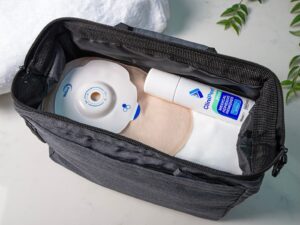A hernia is where part of the bowel pushes through the abdominal muscles causing a bulge. A parastomal hernia is when this happens under the skin around the stoma. This can cause discomfort and pain and may make it more difficult for your stoma bag to stay in place.
What products can help with a parastomal hernia?
Because of the bulge created by the parastomal hernia you may have issues getting a good seal between the skin and stoma bag. Aura Plus Soft Convex stoma bags have a unique plus-shaped flange that moulds to the shape of the area around your stoma. This helps to ensure you’ll have a leak-free fit. HydroFrame and UltraFrame flange extenders can also help provide extra security. Flange extenders increase the area of the flange and are flexible which helps the flange to stick securely when the surface is uneven.
HydroFrame flange extenders have medical grade Manuka honey in the hydrocolloid which may help to promote healthy skin around the stoma. This can be beneficial to people with a parastomal hernia as the skin around your stoma may be more delicate. The Aura Plus range of stoma bags all contain medical grade Manuka Honey in the hydrocolloid also making them skin friendly. You can also help protect your skin by using a barrier film like CliniShield Advance and a medical adhesive remover like CliniPeel. CliniShield Advance creates a protective layer reducing the risk of irritation and damage. CliniPeel uses silicone to release the stoma pouch easily and without pain.
Can I do anything to minimise the risk of a parastomal hernia?
There are a range of reasons parastomal hernias form including repetitive coughing, infection and being above a healthy weight. So, you can take steps to minimise the risk of a hernia by looking after your health. There are also support garments you can wear after surgery that may minimise the risk of a hernia developing. Strengthening the core and abdominal muscles can also be beneficial. We’ve put together a guide to help ostomates reduce the risk of developing a parastomal hernia. The Breathing and Movements Guide has been developed by Stoma Care Nurses and Andy, a qualified Pilates Instructor, and it’s completely free. You can also follow the programme with videos on YouTube.



